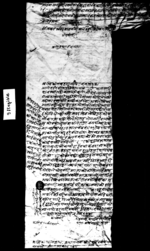A copy of a rukkā from King Pṛthvī Vīra Vikrama authorizing Khimānātha to serve as abbot of Rānāgāũ monastery (VS 1938)
ID: K_0097_0039
Edited and
translated by Christof Zotter
Created: 2019-05-20;
Last modified: 2019-12-05
For the metadata of the document, click here
The accompanying edition, translation/synopsis and/or commentary are available under the terms of the Creative Commons Attribution-ShareAlike 4.0 International License
Abstract
In the rukkā of which the present document is a copy, the king, who according to the date must have been Pṛthvī Vīra Vikrama, confirms Khimānātha as successor of Jagadīśvaranātha on the gaddī of Siddha Bhagavantanātha's maṭha in Rānāgāũ, Salyan.Diplomatic edition
[1r]
1श्रीदुर्गाज्यूः\1श्रीसिद्धभगव़न्तनाथ•2१1श्रीमद्दतीप्रच
2ण्डभुजदण्डे
3त्यादीश्रीश्री
4श्रीमहाराज
5रणउद्दीपसीं
6हराणावहा
7दुरके•सीये़स
8आईयोङ्ली•
9रपीम्माको
10काङ्वाङ्
11स्यान•प्राई
12ममिनीष्टर
13याण्डकम्यां
14डरईन्चीफ्
15२[seal of Hīrānātha]1[?]क्कल्वमोजीम्नक्कल्दुरुस्त
2छभनी•सहिछाप्गर्न्याहीरा
3नाथजी¯¯¯¯¯¯¯¯¯¯¯¯1स्वस्तिश्रीमन्महाराजाधिराजकस्यरुक्का¯¯¯¯¯
2आगेमहंतगोसाईषिमानाथके¯ ¯ १ ¯ ¯कामठगद्दी
3मा•वस्न्यागद्दीकामालीक्ले•जौन्चेलालाईपि
4ठीञामाधापदीगद्दीसोपिजाँथ्या•सोहिचेलाले
5गद्दीमावस्नुभनि•अघीकावंदेजर•अघीदेषि•चली
6आय़ावमोजीम•मेरागुरुगोसाञी•जगदीश्वरना
7थवाटमेरापिठीञाँमाधापदीय़ोमठगद्दी•तला
8ईसोपिदीञ्योभनि•सनदस्मेत•लेषिगुरुकोप
9र्लोकभय़ापछी•मैले•सोमठ्भोगगरि•वस्याको
10छुसोवमोजीम•अघीमेरागुरु•जगदीसश्वरनाथ
11कानाऊमा१९०४सालचैत्रवदी११रोज५माभ
12य़ाकालालहमोहर•वमोजीम•मेरानाउमासनद
13गरिदीनुभंन्या•हुकुम्वक्स्याकोहो•सनदभय़ा
14कोछैनभनि•तिमिले¯ ¯ २¯ ¯रश्रीमद्राजकुमारकु
15मारात्मज•श्रीकम्यांडरईनछीफ्जनरल•धीरस
16म्सेरजंराणावहादुर•मार्फत•हाम्राहजुरमावींतीपा
17र्दा•सो¯ ¯ १¯ ¯कोमठगद्दी•तीम्रागुरुजगदीस्वरना
18थले•तीमिलाईअषतीय़ारगरितीमिलाईदी
19य़ाको•तिम्रागुरुजगदीस्वरनाथ•परलोक हुदा•
20तीमीलेभोगगरि•आय़ाकोतीमी•लाईअष
21तीय़ारगरि•थामीवक्स्यौंआफ्नाषातीरज्मासीत•
22अघीदेषिचलिआय़ाका•रीतवमोजीम•काम
23काजगरि•आफुलाईदरिय़ाकाजगाकोदाम
24काम•असुल•तहसीलगरि¯ ¯ १¯¯कामठ्गदीमा
25अघीदेषी•दरिचलीआय़ावमोजीम•कत्तीघटीव
26ढीनपारिनित्यनैमित्यकपुजा •भंडाराचला
27ईहाम्रो जय़मनाईभोग्येगरभंयामहंत्याइँको
28लालमोहरगरिवक्स्यौं•ईतिसम्वत्१९३८सा
29लमिती•फागुणवदी२रोज१शुभ्म्¯¯¯¯¯¯¯¯
Translation
[1r]
[above the main text:]1
Glorious (śrī) Durgājyū
Venerable SiddhaBhagavantanātha 1
[in the left margin:]
The thrice venerable great king, who is illustrious, very mighty and has arms like a staff etc., Raṇa Uddīpa Siṃha Rāṇā Bahādūra, KCSI, thoṅ-līṅ-pim-mā-ko-kāṅ-vāṅ-syān, prime minister and commander-in-chief2 2
[seal of Hīranātha]3
Attesting that the copy is true to the original, Hīrānātha-jī
[main text:]
Hail. [This is] an executive order of the supreme king of great kings.4
Āge: to MahantaGosāī̃Khimānātha5
You have submitted a petition to us through [Prime Minister and Commander-in-Chief Raṇa Uddīpa Siṃha Rāṇā Bahādura (...)]6 and the venerable prince born of a prince, Commander-in-Chief General Dhīra Śamśera Jaṅga Rāṇā Bahādura, stating: "According to the rule (bandeja) of earlier times7 that states: 'The disciple who has been slapped on the back and to whom the throne has been entrusted by the master (mālika) of the throne (he who sits on the throne of the monastery of [the Venerable Siddha Bhagavantanātha]8 ) shall occupy the throne', and in accordance with what has been practised since early times, my guru, Gosāī̃ Jagadīśvaranātha,9 slapped [me] on the back [and] wrote an order (sanada) that states: 'This throne of the monastery is entrusted to you',10 [and] ever since my guru passed away11 I have been exercising authority over that monastery. Following that [customary practice,] a lālamohara in the name of my guru Jagadīśvaranātha was issued in VS 1904, Caitra vadi 11, Thursday,12 [and] according to it the order (hukuma) has been given that a sanada in my name should be issued, [but such a] sanada has not been [issued yet.]"13 We have therefore confirmed your authority, [which] you have been exercising [ever since] your guru Jagadīśvaranātha passed away, [that same] guru of yours, Jagadīśvaranātha, having given you authority [over] the throne of the monastery of [the venerable Siddha Bhagavantanātha]14 . We have issued a lālamohora conferring abbotship (mahantyāĩ) that states: 15 Enjoy [what is yours], doing [your] work dutifully according to the customs that have been practised before, collecting the income due on the land registered in your name, as practised before, without any decrease or increase, conducting the daily and occasional pūjās and observing feasts from the throne of the monastery of [the venerable Siddha Bhagavantanātha]16 , and celebrating our triumphs.
Sunday, the 2nd of the dark fortnight of Phālguna of the [Vikrama] era year 1938 (1882 CE).17 Auspiciousness.
Commentary
Khimānātha had earlier, in VS 1935, received confirmation of his abbotship from Lieutenant General Vīra Śamśera Jaṅga Bahādura Rāṇā (see K_0097_0040). The sanada he is asking for in the petition, to which the present document is a response, is a confirmation of his abbotship by the king similar to the above-mentioned mahantyāĩko lālamohara Jagadīśvaranātha received in VS 1904 (see K_0468_0062).
Khimānātha's abbotship lasted for less than a decade, but it was eventful. He was, for example, involved in several court cases (see Zotter 2018: 455f. with further references). He passed away in VS 1943, Āśvina sudi 4, Friday (cf. K_0097_0038), one day after he wrote a sanada for his disciple and successor Hīrānātha (see K_0097_0041). Hīranātha, who attested the present copy (probably in the process of applying for his own mahantyāĩko lālamohara), received the desired royal confirmation in VS 1944, Māgha vadi 8, Saturday (see K_0469_0024), after his claim to the office was reviewed by different government institutions (see K_0097_0038, K_0097_0042 and K_0097_0043).

